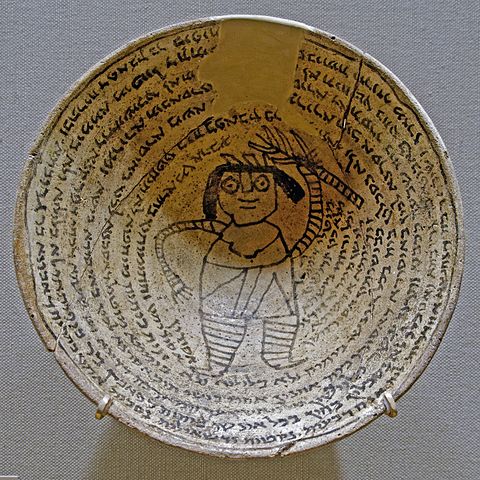Difference between revisions of "Template:POTD protected"
Occultwiki (talk | contribs) |
Occultwiki (talk | contribs) |
||
| Line 1: | Line 1: | ||
{| role="presentation" style="margin:0 3px 3px; width:100%; text-align:left; background-color:transparent; border-collapse: collapse; " | {| role="presentation" style="margin:0 3px 3px; width:100%; text-align:left; background-color:transparent; border-collapse: collapse; " | ||
|style="padding:0 0.9em 0 0;" | [[File: | |style="padding:0 0.9em 0 0;" | [[File:Incantation bowl Lilith.jpg|300px|thumb|]] | ||
|style="padding:0 6px 0 0"| | |style="padding:0 6px 0 0"| | ||
'''[[ | An individual '''[[Lilith]]''', along with Bagdana "king of the lilits", is one of the demons to feature prominently in protective spells in the eighty surviving Jewish [[occult]] incantation bowls from Sassanid Empire Babylon (4th–6th century AD) with influence from Iranian culture. These bowls were buried upside down below the structure of the house or on the land of the house, in order to trap the demon. Almost every house was found to have such protective bowls against [[demon]]s. | ||
The | The center of the inside of the bowl depicts Lilith, or the male form, Lilit. Surrounding the image is writing in spiral form; the writing often begins at the center and works its way to the edge. The writing is most commonly scripture or references to the Talmud. The incantation bowls which have been analysed, are inscribed in the following languages, Jewish Babylonian Aramaic, Syriac, Mandaic, Middle Persian, and Arabic. Some bowls are written in a false script which has no meaning. | ||
<p><small> | <p><small>Photo Credit: University of Pennsylvania Museum of Archaeology and Anthropology</small></p> | ||
[[:Category:Images|'''(More Images)''']] | [[:Category:Images|'''(More Images)''']] | ||
<div class="potd-recent" style="text-align:right;"> | <div class="potd-recent" style="text-align:right;"> | ||
Revision as of 00:08, 13 November 2023
|
An individual Lilith, along with Bagdana "king of the lilits", is one of the demons to feature prominently in protective spells in the eighty surviving Jewish occult incantation bowls from Sassanid Empire Babylon (4th–6th century AD) with influence from Iranian culture. These bowls were buried upside down below the structure of the house or on the land of the house, in order to trap the demon. Almost every house was found to have such protective bowls against demons. The center of the inside of the bowl depicts Lilith, or the male form, Lilit. Surrounding the image is writing in spiral form; the writing often begins at the center and works its way to the edge. The writing is most commonly scripture or references to the Talmud. The incantation bowls which have been analysed, are inscribed in the following languages, Jewish Babylonian Aramaic, Syriac, Mandaic, Middle Persian, and Arabic. Some bowls are written in a false script which has no meaning. Photo Credit: University of Pennsylvania Museum of Archaeology and Anthropology |
